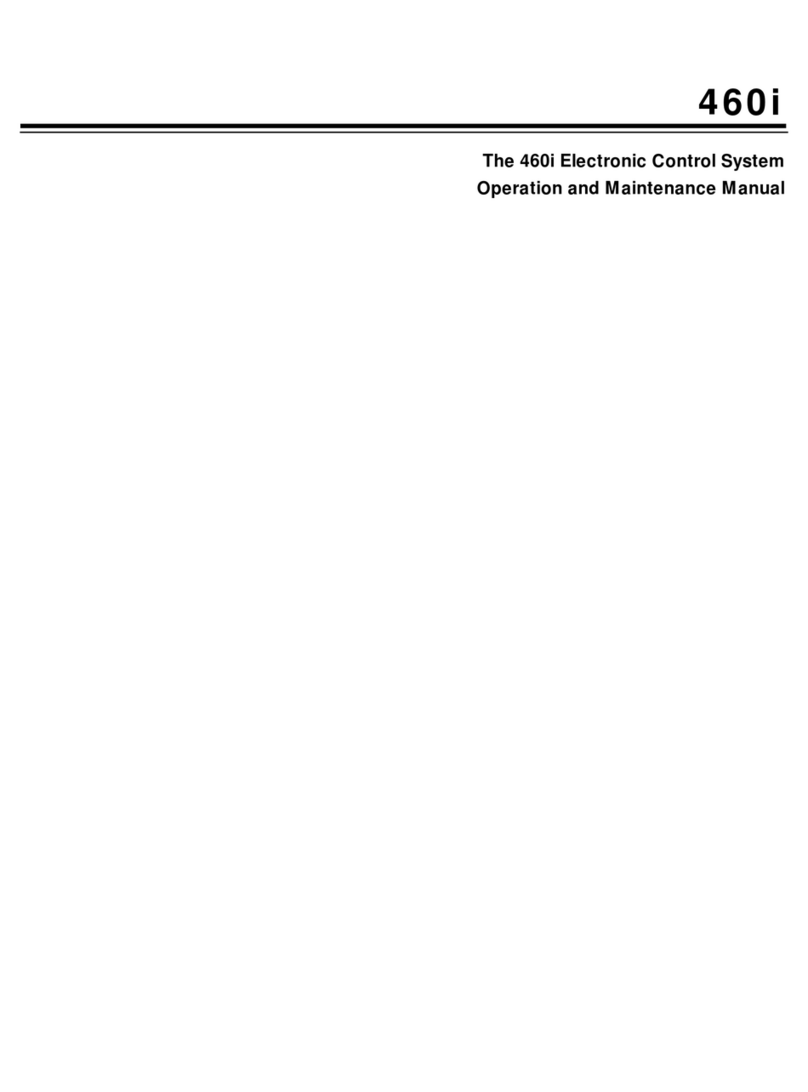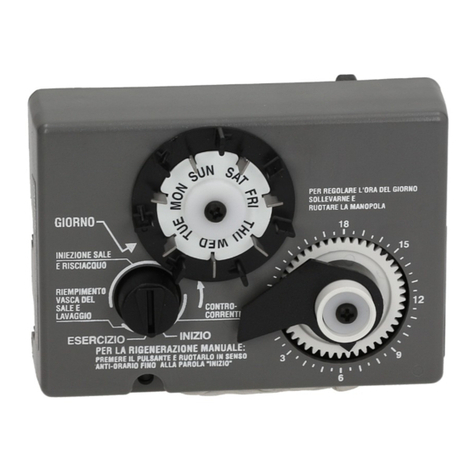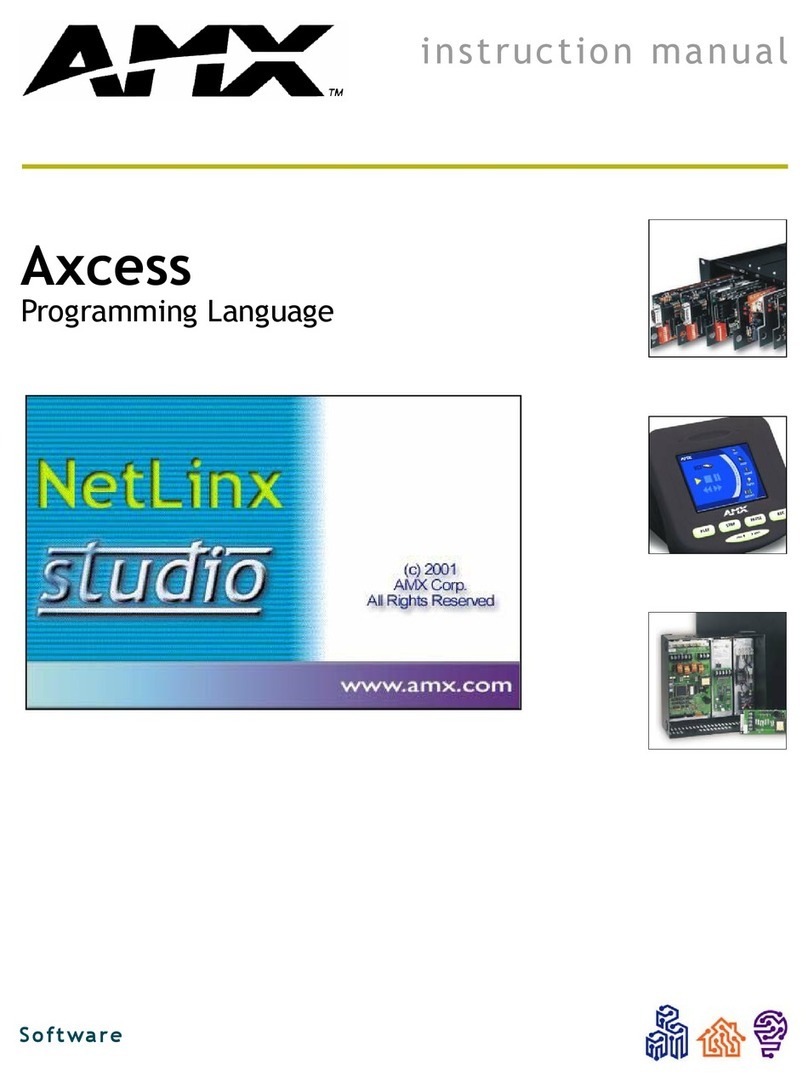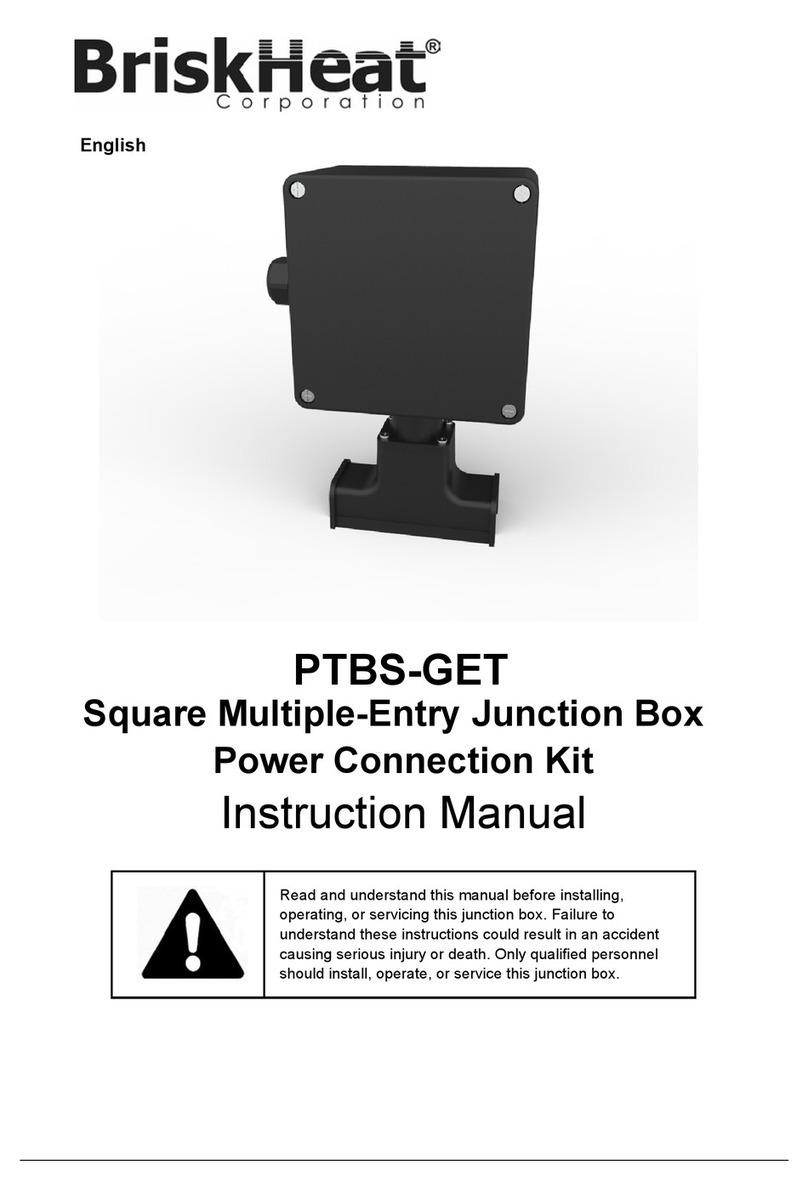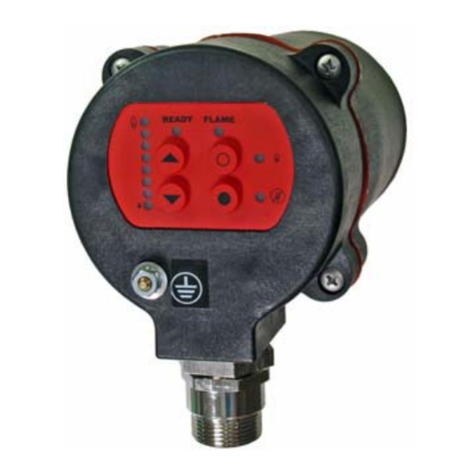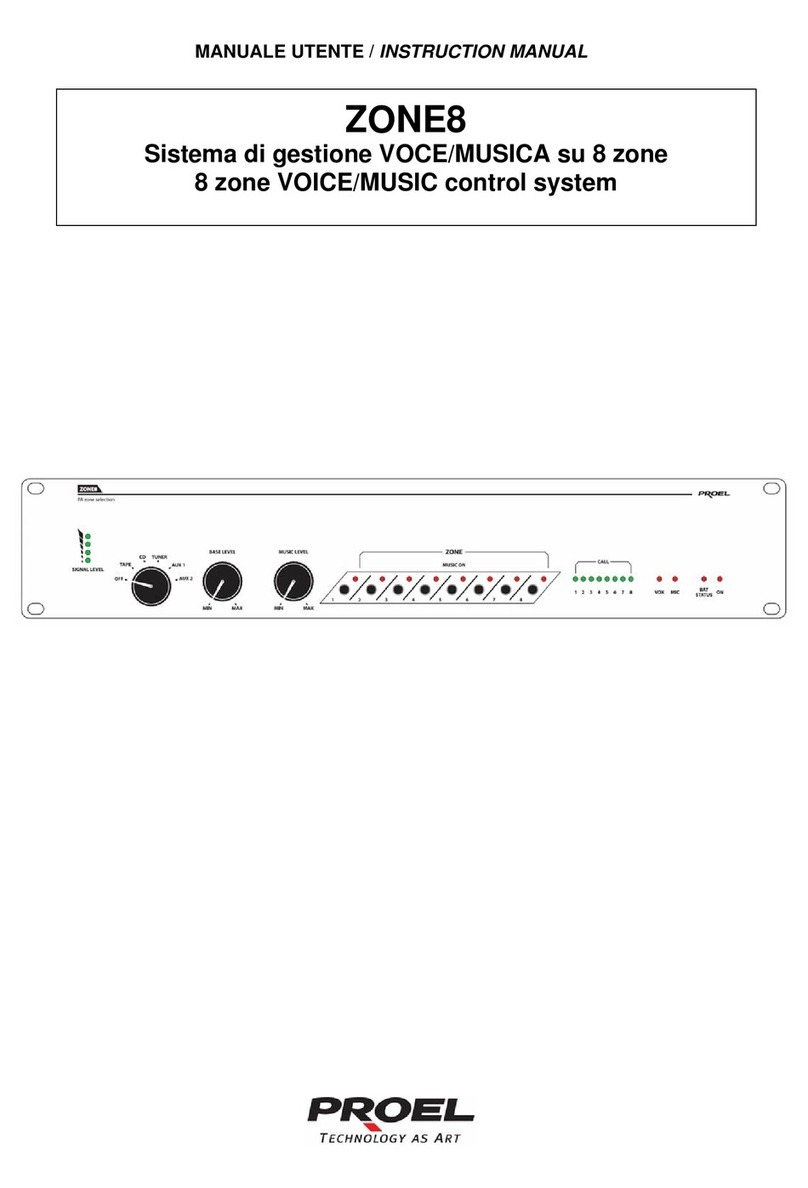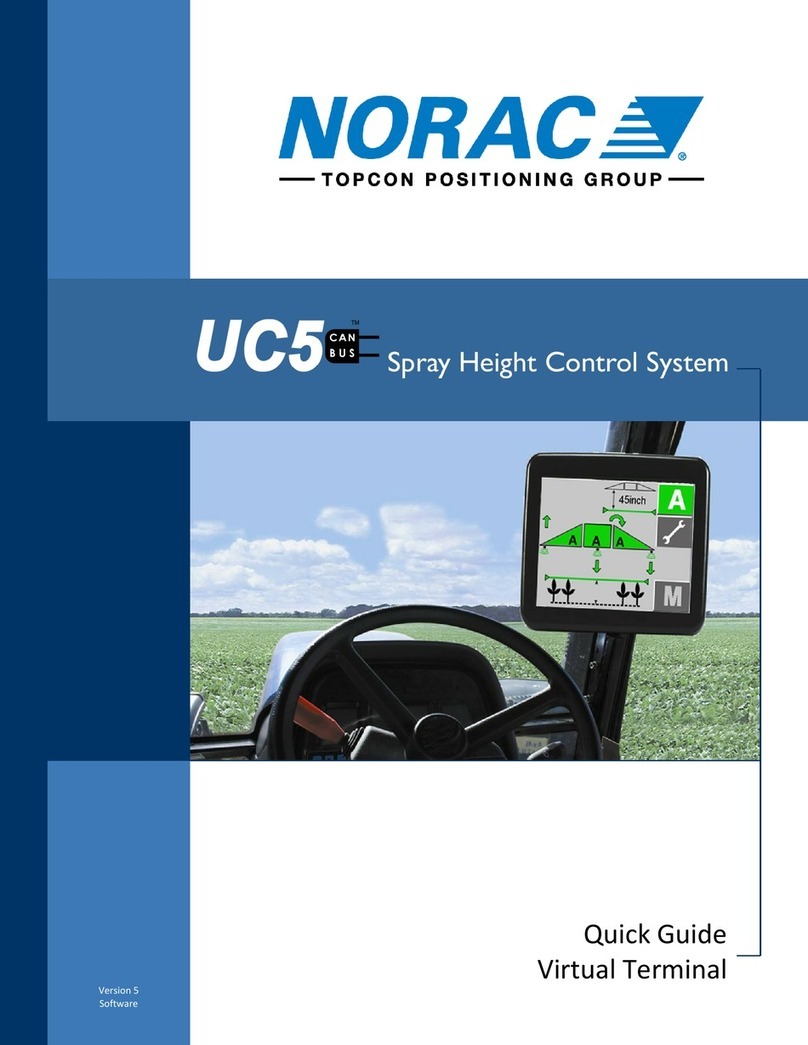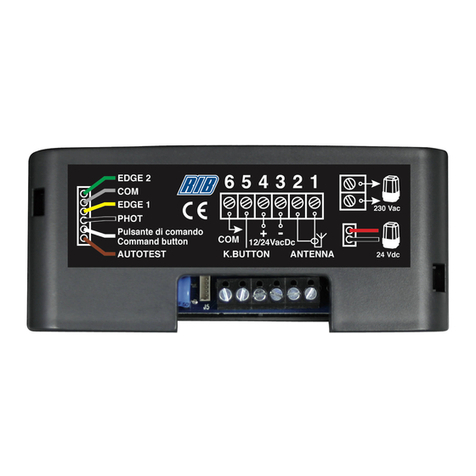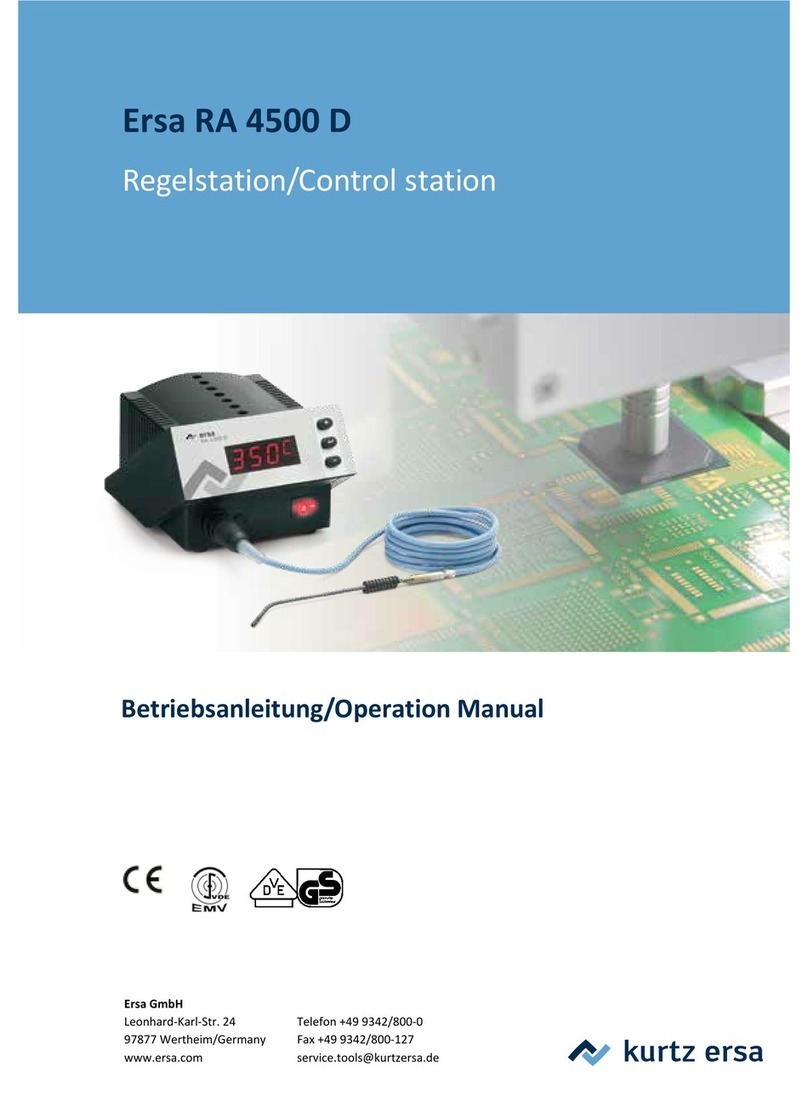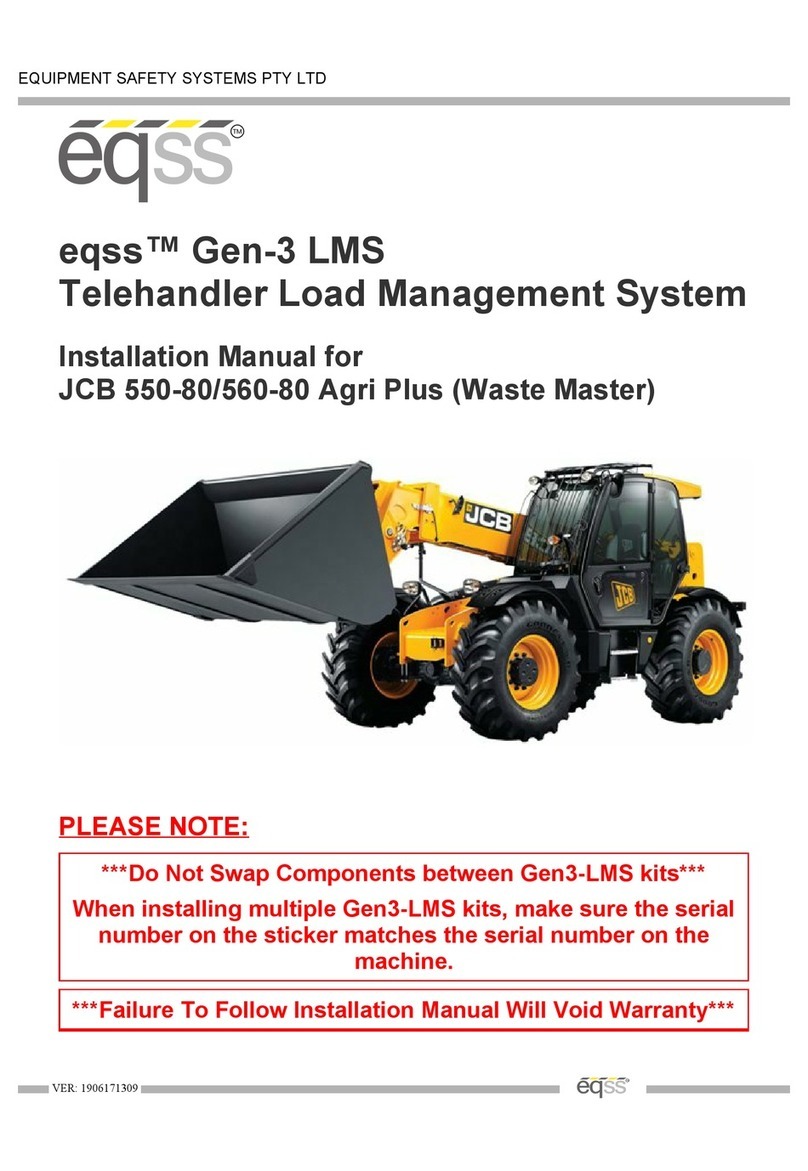Autotrol 255 Series User manual

1
Autotrol®Series 255 Valve / 440i Control
Water Conditioning Control System
Installation, Operation and Maintenance Manual
Osmonics reserves the right to revise specifications and designs to improve products at any time without notice.
© 1999 Osmonics Printed in USA R-409 8/99 PN 1018075 Rev. C

2
Introduction
The Series 255 control system combines design
simplicity with NORYL* construction to provide the
user with an uncommonly reliable appliance. The
inherent reliability of the system means a long life of
efficient, trouble-free, uninterrupted soft water luxury.
Should maintenance become necessary, the Series 255
control system offers a unique “separation” capability
illustrated in this manual.
Of interest to the owner and water conditioning dealer
are the design and operation benefits detailed below.
Superior Design
•Fewer parts than any control system of comparable
function and most controls of lesser function.
•Single synchronous low voltage electric motor
provides all the power for the clock 440i timer and
the operation of the control.
•Program clock (timer) provides guest regeneration
capabilitiy.
•Control may be indexed manually with or without
power to its service or regeneration positions. Legend
on timer face plate indicates control valve position.
•No moving parts in water stream means no close
tolerance components subject to fouling. Thus, the
system is especially effective on iron-bearing water.
•No dynamic seals that could cause leakage
through wear or fatigue.
•Control accepts NORYL or brass manifold or
modular bypass valve without modification,
offering complete versatility and easy plumbing for
any installation.
•Brining control valve built into system eliminates
need for an external brine valve.
•Automatic drain flow controller is incorporated in
the system.
Superior Operation
•Direct acting system functions independently of
water pressure. No pistons or diaphragms that
require a minimum water pressure to operate.
•Five-cycle operation provides for downflow
service, upflow backwash, downflow brining,
downflow rinse, downflow purge (fast rinse). A sixth
position is included for timed refill of the brine tank.
•Valve discs are held closed by water pressure
and therefore, are leak tight. The sealing forces are
increased as the water pressure is increased. Valve
seats are in a vertical position, which is the design
position least vulnerable to plugging.
•System operation cannot get out of phase or
sequence. Control always returns to a fixed service
position after regeneration regardless of where in
the regeneration cycle it was started.
•Bypass water is automatically available during
regeneration.
Table of Contents
Introduction ...................................................... 2
Superior Design
Superior Operation
Installation ........................................................ 3
Location Selection
Water Line Connection
Drain Line Connection
Overflow Line Connection
Electrical Connection
Increasing the Length of the
Transformer Cord ............................................ 5
Placing Conditioner into Operation ............... 5
Adjustment of Timer ........................................ 6
Special Features of Timer ............................... 7
Adjustment of Brine Control........................... 7
How to Set the Salt Dial
Removing the Series 255
Control Module for Servicing ......................... 8
Preventive Maintenance.................................. 9
Specifications................................................. 10
Pressure Graphs ............................................ 11
Flow Diagrams ............................................... 12
Replacement Parts ........................................ 14
Troubleshooting ............................................. 18
Disinfection of Water Conditioners.............. 19
* NORYL is a Trademark of General Electric Company
19
Disinfection of Water Conditioners
The materials of construction of the modern water
conditioner will not support bacterial growth, nor will
these materials contaminate a water supply. However,
the normal conditions existing during shipping, storage
and installation indicate the advisability of disinfecting
a conditioner after installation, before the conditioner
is used to treat potable water. In addition, during
normal use, a conditioner may become fouled with
organic matter, or in some cases, with bacteria from
the water supply.
Thus every conditioner should be disinfected after
installation, some will require periodic disinfection
during their normal life, and in a few cases disinfection
with every regeneration would be recommended.
Depending upon the conditions of use, the style of
conditioner, the type of ion exchanger, and the disin-
fectant available, a choice can be made among the
following methods.
Sodium or Calcium Hypochlorite
Application
These materials are satisfactory for use with polystyrene
resins, synthetic gel zeolite, greensand and bentonites.
5.25% Sodium Hypochlorite
These solutions are available under trade names such as
Clorox, Linco, Bo Peep, White Sail and Eagle Brand
Bleach. If stronger solutions are used, such as those sold
for commercial laundries, adjust the dosage accordingly.
1. Dosage
a. Polystyrene resin; 1.2 fluid ounce per cubic foot.
b. Non-resinous exchangers; 0.8 fluid ounce per
cubic foot.
2. Brine tank conditioners
a. Backwash the conditioner, and add the required
amount of hypochlorite solution to the brine well
of the brine tank. (The brine tank should have
water in it to permit the solution to be carried into
the conditioner.)
b. Proceed with the normal regeneration.
Calcium Hypochlorite
Calcium hypochlorite, 70% available chlorine, is
available in several forms including tablets and gran-
ules. These solid materials may be used directly,
without dissolving before use.
1. Dosage
a. 2 grains (approximately 0.1 ounce) per cubic foot.
2. Brine tank conditioners
a. Backwash the conditioner and add the required
amount of hypochlorite to the brine well of the
brine tank. (The brine tank should have water in it
to permit the chlorine solution to be carried into
the conditioner.)
b. Proceed with the normal regeneration.
Problem Possible Cause Solution
8.Control backwashes or purges at a. Incorrect drain controller used. a. Replace with correct size drain controller.
excessively low or high rate.
b. Foreign matter affecting controller operation. b. Remove drain controller and clean ball and seat.
9. Flowing or dripping water at drain a. Drain valve (5 or 6) or brine valve (1) a. Manually operate valve stem to flush
or brine line after regeneration. held open by foreign matter or particle. away obstruction.
b.Valve stem return spring weak. b.Replace spring.
10. Hard water leakage after a. Improper regeneration. a. Repeat regeneration making certain
regeneration correct salt dosage was set.
b.Leaking of external bypass valve. b.Replace o-ring.
c. O-ring around riser pipe damaged. c. Replace o-ring.
d.Leaking past bypass valve disc. d.Replace valve disc.

Figure 1 Autotrol Series 256 Bypass Valve
3
Figure 2 Typical globe valve bypass system
Installation
All plumbing must conform to local codes.
Inspect unit carefully for carrier shortage or shipping
damage.
Location Selection
1. The distance between the unit and a drain should
be as short as possible.
2. If it is likely that supplementary water treating
equipment will be required, make certain adequate
additional space is available.
3. Since salt must be added periodically to the brine
tank, the location should be easily accessible.
4. Do not install any unit closer to a water heater than
a total run of 10 feet (3 m) of piping between the
outlet of the conditioner and the inlet to the heater.
Water heaters can sometimes overheat to the
extent they will transmit heat back down the cold
pipe into the unit control valve.
Hot water can severely damage the conditioner.
A 10 foot (3 m) total pipe run, including bends,
elbows, etc., is a reasonable distance to help
prevent this possibility. A positive way to prevent
hot water from flowing from heat source to the
conditioner, in the event of a negative pressure
situation, is to install a check valve in the soft water
piping from the conditioner. If a check valve is
installed, make certain the water heating unit is
equipped with a properly rated temperature and
pressure safety relief valve. Also, be certain that
local codes are not violated.
5. Do not locate unit where it or its connections
(including the drain and overflow lines) will ever be
subjected to room temperatures under 34°F (1°C)
or over 120°F (49°C).
6. Do not install unit near acid or acid fumes.
7. The use of resin cleaners in an unvented enclosure
is not recommended.
Water Line Connection
The installation of a bypass valve system is recommended
to provide for occasions when the water conditioner must
be bypassed for hard water or for servicing.
The most common bypass systems are the Autotrol
Series 256 Bypass Valve (Figure 1) and plumbed-in
globe valves (Figure 2). Though both are similar in
function, the 256 Autotrol Bypass offers simplicity and
ease of operation.
Not in Bypass In Bypass
Water Water
Conditioner Conditioner
Not in Bypass In Bypass
Water Water
Conditioner Conditioner
Drain Line Connection
1. Ideally located, the unit will be above and not more
than 20 feet (6.1 m) from the drain. For such installa-
tions, using an appropriate adapter fitting (not
supplied), connect 1/2 inch (1.3 cm) plastic tubing
to the drain line connection of the control valve.
2. If the unit is located more than 20 feet (6.1 m) from
drain, use 3/4-inch (1.9 cm) tubing for runs up to 40
feet (12.2 m). Also, purchase appropriate fitting to
connect the 3/4-inch tubing to the 1/2-inch NPT
drain connection.
3. If the unit is located where the drain line must be
elevated, you may elevate the line up to 6 feet (1.8 m)
providing the run does not exceed 15 feet (4.6 m)
and water pressure at conditioner is not less than 40
psi (2.76 bar). You may elevate an additional 2 feet
(61 cm) for each additional 10 psi (.69 bar).
4. Where the drain line is elevated but empties into a
drain below the level of the control valve, form a 7
inch (18 cm) loop at the far end of the line so that
the bottom of the loop is level with the drain line
connection. This will provide an adequate siphon
trap.
5. Where the drain empties into an overhead sewer
line, a sink-type trap must be used.
18
Troubleshooting
The technology upon which the Series 255 control is based is well established and proven in service over many
years. However, should a problem or question arise regarding the operation of the system, the control can be very
easily serviced. The control module can be quickly replaced or adjustments can be made at the installation. For
parts mentioned, refer to exploded views in the Replacement Parts section of this manual.
Problem Possible Cause Solution
1.Control will not regenerate a. Transformer or motor not connected. a. Connect power.
automatically. b.Defective timer motor. b.Replace motor.
c. Skipper pins not down on timer skipper c. Depress pins for days regeneration
wheel. required.
d.Binding in gear train of timer. d.Replace timer.
2.Control regenerates at wrong a. Time set incorrectly. a. Correct time setting according
time of day. to instructions.
3. Control will not draw brine. a. Low water pressure. a. Set pump to maintain 20 psi at softener.
b.Restricted drain line. b.Change drain to remove restriction.
c. Injector plugged. c. Clean injector and screen.
d.Injector defective. d.Replace injector.
e. Valve disc 2 and/or 3 not closed. e. Remove foreign matter from disc and check
disc for closing by pushing in on stem.
Replace if needed.
f. Air check valve closes prematurely. f. Put control momentarily into brine/slow rinse.
Replace or repair air check if needed.
g.Timer locking pin not horizontal g.Turn to horizontal position.
4.Brine tank overflow. a. Brine valve disc 1 being held open a. Manually operate valve stem to flush
by foreign matter. away obstruction.
b.Uncontrolled brine refill flow rate. b.Remove brine control to cleanball and
seat.
c. Valve disc 2 not closed during brine c. Flush out foreign matter holding disc
draw causing brine refill. open by manually operating valve stem.
d. Air leak in brine line to air check. d. Check all connections in brine line for
leaks. Refer to instructions.
e. Improper drain control for injector. e. Too small of a drain control with a "B" or
"C" injector will reduce draw rates. See
Pressure Graphs.
f. Drain control clogged with resin or f. Clean drain control.
other debris.
5.System using more or less salt a. Foreign matter in controller causing a. Remove brine control and flush out
than salt dial setting. incorrect flow rates. foreign matter. Manually position control
to brine/slow rinse to clean controller
(after so doing position control to “purge”
to remove brine from tank)
b.Defective controller. b.Replace brine control.
6. Intermittent or irregular brine draw. a. Low water pressure. a. Set pump to maintain 20 psi at softener.
b. Defective injector. b.Replace injector.
7.No conditioned water after a. No salt in brine tank. a.Add salt to brine tank.
regeneration. b.Injector plugged. b.Clean injector and screen.
c. Air check valve closes prematurely. c. Put control momentarily into brine/slow rinse.
Replace or repair air check if needed.

4
Important
Never insert drain line into a drain, sewer line or
trap. Always allow an air gap between the drain
line and the wastewater to prevent the possibility
of sewage being back-siphoned into conditioner.
Figure 3
Note: Standard commercial practices have been
expressed here. Local codes may require changes to
these suggestions.
Brine Line Connection
It will be necessary to install the brine tube and line to a
fitting installed on the air check. Teflon* tape all
threaded connections.
Be sure all fittings and connections are tight so that
premature checking does not take place. Premature
checking is when the ball in the air check falls to the
bottom before all brine is drawn out of the brine tank.
See Placing Conditioner into Service section.
Overflow Line Connection
In the absence of a safety overflow and in the event of
a malfunction, the BRINE TANK OVERFLOW will direct
“overflow” to the drain instead of spilling on the floor
where it could cause considerable damage. This fitting
should be on the side of the cabinet or brine tank.
To connect overflow, locate hole on side of brine tank.
Insert overflow fitting (not supplied) into tank and
tighten with plastic thumb nut and gasket as shown
(Figure 4). Attach length of 1/2-inch (1.3 cm) I.D. tubing
(not supplied) to fitting and run to drain. Do not elevate
overflow line higher than 3 inches (7.6 cm) below
bottom of overflow fitting. Do not tie into drain line of
control unit. Overflow line must be a direct, separate
line from overflow fitting to drain, sewer or tub. Allow
an air gap as per drain line instructions (Figure 3).
Right Way
Overflow
Installed
Brine Tank
Connect 1/2 in (1.3 cm) I.D.
Tubing or Hose and Run
to Drain Figure 4
Low Voltage Transformer
Only use the included transformer for powering the
440i timer. Connect the plug of the transformer sec-
ondary cable to the mating socket at the rear of the
timer housing on the motor.
Be certain that the transformer is plugged into a correct
voltage source that is not controlled by a wall switch.
Fitting
* Teflon is a registered trademark of E.I. Dupont & Co. 17
440i Timer
Part
Code No. Description Qty.
1 Skipper Wheel Assembly: 1
1031740 6-Day
1031742 7-Day
2 1030659 Washer 1
3 1006091 Screw, No. 6 x 1/2 in 2
4 1006601 Bowed Washer 1
5 1031756 Tripper Arm Assembly 1
6 1030830 Spring 1
7 1030821 Retainer 1
8 1001569 Motor, 12 Volt, 60 Hz 1
9 Transformer:
1000810 Japanese
1000811 North American
1000812 Australian
1000813 British
1000814 European
* 1000907 Transformer Extension Cord 1
15 ft. (4.6 m)
Piping Boss
Part
Code No. Description Qty.
1 Piping Boss Kit 1
(Includes Hardware):
1040277 3/4 in NPT, Brass,
3/8 in NPT Drain
1040278 1 in NPT, Brass,
1/2 in NPT Drain
1040281 3/4 in BSPT, Brass,
3/8 in BSPT Drain
1040282 1 in BSPT, Brass,
1/2 in BSPT Drain
1040279 3/4 in NPT, Noryl,
1/2 in NPT Drain
1040280 1 in NPT, Noryl,
1/2 in NPT Drain
1040283 3/4 in BSPT, Noryl,
1/2 in BSPT Drain
1040284 1 in BSPT, Noryl,
1/2 in BSPT Drain
2 1040339 Piping Boss Installation Kit 1
Bypass Valve
Part
Code No. Description Qty.
1 1040769 Bypass Body Assembly 1
2 1040524 Bypass Installation Kit 1
Service Kits:
* 1034301 Rotor Replacement
* 1034302 Kit, Service, Rotor Seals and Two Clips
* 1034303 24pk, Rotor Clips
Tube Adapter Kits
Part
Code No. Description Qty.
* 1001606 3/4 Inch Copper Tube Adapter Kit 1
* 1001670 1 Inch Copper Tube Adapter Kit 1
* 1001608 22mm Copper Tube Adapter Kit 1
* 1001609 28mm Copper Tube Adapter Kit 1
* 1001613 3/4 Inch CPVC Tube Adapter Kit 1
* 1001614 1 Inch CPVC Tube Adapter Kit 1
* 1001615 25mm CPVC Tube Adapter Kit 1
* 1001769 3/4 Inch NPT Plastic Pipe Adapter Kit 1
* 1001603 1 Inch NPT Plastic Pipe Adapter Kit 1
* 1001604 3/4 Inch BSPT Plastic Pipe Adapter Kit 1
* 1001605 1 Inch BSPT Plastic Pipe Adapter Kit 1
* 1001611 3/4 Inch BSPT Brass Pipe Adapter Kit 1
* 1001610 1 Inch NPT Brass Pi0pe Adapter Kit 1
* 1001612 1 Inch BSPT Brass Pipe Adapter Kit 1
* Not Shown

5
Placing Conditioner into Operation
After all previous steps have been completed, the unit
is ready to be placed into operation. Follow these
steps carefully.
1. Remove control valve cover (Figure 10A).
Note: The following steps will require turning the
pointer knob, (Figure 8), to various positions. Insert
a wide blade screwdriver into arrow slot in pointer
knob and press in firmly. With knob held in, rotate
COUNTERCLOCKWISE only until arrow or knob
points to desired position. (Rotation is made much
easier if you grasp the camshaft with your free hand
and turn it at the same time.) Then permit knob to
spring back out.
2. Insert screwdriver into slot in pointer knob, (Figure 8).
Press in and rotate knob COUNTERCLOCKWISE
until arrow points directly to the word BACKWASH.
3. Fill resin tank with water.
A. With water supply off, place the bypass valve(s)
into the "not in bypass" position.
B. Open water supply valve very slowly to approxi-
mately the 1/4 open position.
Important
If opened too rapidly or too far, resin may be
lost. In this position, you should hear air
escaping slowly from the drain line.
C. When all of the air has been purged from the
tank(water begins to flow steadily from the drain),
open the water supply valve all the way.
D. Allow water to run to drain until clear.
E. Turn off water supply and let the unit stand for
about 5 minutes. This will allow all trapped air to
escape from the tank.
4. Add water to brine tank (initial fill).
With a bucket or hose, add approximately 4 gallons
(15 liters) of water to brine tank. If the tank has a
salt platform above the bottom of the tank, add
water until the level is approximately 1inch (25 mm)
above the platform.
Increasing the Length of the
Transformer Cord
If it is necessary to extend the length of the transformer
cord, an optional 15 foot (4.6 m) extension is available,
(see Figure 5) or the cord may be spliced as follows:
1. Strip insulation from wire 5/16-inch(8mm) from wire
end.
2. Insert stripped wire into barrel of connector and
crimp. For best results, crimp twice per wire as
shown (Figure 6).
Splice connectors or extension wire is not supplied.
They are available at hardware or electrical stores.
Figure 5
50 feet(15.24m) maximum, 18 AWG solid
or stranded insulated copper wire.
Figure 6
Splice Connector
(22-18 AWG)
16
440i Timer
Bypass Valve
Piping Boss
Note: Do not use pipe joint compound
when threading pipe into the Noryl piping
boss. Use only Teflon®pipe tape. Do not
overtighten pipe into Noryl piping boss.
* Teflon is a registered Trademark of E. I.
Dupont Nemours and Co.
B
Y
P
A
S
S
B
Y
P
A
S
S
2
2
1
2
34
5
6
78
9
3
1
1

TO SETTIME OF DAY
PULL KNOB AND ROTATE
MANUAL REGENERATION:
PRESS KNOB AND TURN CLOCKWISE
TO “START” –
RELEASE
DAY
BRINE/
SLOW RINSE
FAST RINSE/ BACKWASH
START
REFILL
CONDITIONED
WATER
6PM
3PM
9AM3AM
6AM
NOONMIDNIGHT
1
7
6
5
4
3
2
6
5. Put into operation.
A. Open water supply valve slowly to full open
position.
B. Carefully advance pointer knob COUNTER-
CLOCKWISE to center of FAST RINSE/REFILL
position and hold there until air check (Figure 7) fills
with water and water starts to flow through brine
line into brine tank. Do not run for more than 2
minutes.
C. Advance pointer knob COUNTERCLOCKWISE
until arrow points to the center of the BRINE/SLOW
RINSE position.
D. With the conditioner in this position, check to
see if water is being drawn from the brine tank. The
water level in the brine tank will recede very slowly.
Observe for at least 3 minutes. If the water level
does not recede or goes up, or if air enters the
transparent air check chamber and the ball falls
and seats, reference Troubleshooting section.
E. Advance pointer knob COUNTERCLOCKWISE
to CONDITIONED WATER.
F. Run water from a nearby faucet until the water is
clear and soft.
Figure 7
Control Valve
Air Check Check Female
Ball Elbow
1. Set days of regeneration on skipper wheel (Figure 8).
• Pull all skipper pins outward (away from control).
• Rotate skipper wheel until day arrow points to
current day or number 1.
• Depress skipper pin(s) at day(s) for which
regeneration is desired.
2. Set the time of day .
• Grasp timer knob and pull outward.
• Rotate in either direction until the timer arrow
points to the actual time of day (Figure 8).
• Release timer knob .
Note: With the time of day properly set, the conditioner
will regenerate at about 2:30 a.m. If you prefer to have
the unit regenerate at an earlier or later time, simply set
the current time-of-day accordingly. (e.g., To have the
unit REGENERATE/BACKWASH at 4:30 a.m. - 2 hours
later -set the clock 2 hours earlier than the actual
current time).
Note: The Timer Locking Pin should always be horizon-
tal (Figure 8) during operation.
Figure 8
Skipper Wheel
Skipper Pins
Day Arrow
Time Arrow
Pointer Knob Timer Knob
Adjustment of Timer
Brine
Line
Timer
Locking Pin
15
Part
Code No. Description Qty.
13 1010429 O-Ring BN 1
14 1010428 O-Ring EP 1
15 Locking Bar: 1
1031402 English Language
1031403 French Language
1031404 German Language
1031405 Italian Language
1031406 Japanese Language
1031407 Spanish Language
16 1006093 Screw, No. 8 x 9/16 in 1
17 1001580 Spring, Valve Discs 9
18 1032565 Valve Cover, Standard, Black 1
19 1000062 i-Lid Cover 1
20 1000297 Extended Connector 1
(For use with i-Lid Cover)
21 High Style Covers:
1041087 Beige/Brown
1041088 Black/White
1041091 Beige/Black
Kits:
22 1033066 New to Old Aircheck Adapter
23 1001404 O-Ring Group: Tank Adapter
1010117 (1), 1010407 (1),
1010410 (4)
24 1040459 O-Ring Group: Piping Boss
1010431 (1), 1010411 (2)
25 1041010 13/16 Rubber Insert (Optional)
Valve Discs:
* 1000250 Standard
* 1000252 Severe Service
Valve
Part
Code No. Description Qty.
1 1000232 Valve Assembly, 1
w/o Flow Controls
2 Camshaft: 1
1031950 Standard, One-Piece
1033024 Standard, Segmented
1033025 Extra Salt, Segmented
1033026 Long Rinse, Segmented
1032969 Water Saver, Segmented
3 1030501 Camshaft Bearing 1
4 1031391 Timer Locking Pin 1
5 1000226 Screen/Cap Assembly 1
with O-Ring
6 Drain Control Assembly 1
with O-Rings:
1000209 No. 7 (1.2 gpm; 4.5 lpm)
1000210 No. 8 (1.6 gpm; 6.1 lpm)
1000211 No. 9 (2.0 gpm; 7.6 lpm)
1000212 No. 10 (2.5 gpm; 9.5 lpm)
1000213 No. 12 (3.5 gpm; 13.2 lpm)
1000214 No. 13 (4.1 gpm; 15.5 lpm)**
1000215 No. 14 (4.8 gpm; 18.2 lpm)**
7 1030502 Ball, Flow Control 2
8 Brine Refill Control: 1
1034261 1 to 10 lbs Salt
1034263 3 to 19 lbs Salt
9 Injector Assembly 1
with O-Rings:
1032970 "A" Injector - White
1032971 "B" Injector - Blue
1032972 "C" Injector - Red
10 Injector Cap with O-Ring: 1
1000217 "A" Cap
1000218 "B" Cap
1000219 "C" Cap
11 1033784 Tank Adapter Assembly 1
12 1032416 Air Check Kit 1
*Not Shown
**Flow control does not use Flow Control Ball (1030502).

7
Guest Cycle
When abnormally high water usage exhausts your
water conditioner’s capacity ahead of schedule, an
extra regeneration can be achieved by depressing the
pointer knob with a wide blade screwdriver and turning
COUNTERCLOCKWISE to START (Figure 8). It will
take a few minutes for regeneration to start. Normal
regeneration schedule will not be disrupted.
Manual Regeneration
Electricity is used only to run the timer and to rotate the
camshaft. All other functions are operated by water
pressure. Therefore, in the event of a power outage, all
the regeneration positions may be dialed manually by
depressing the pointer knob and turning COUNTER-
CLOCKWISE (Figure 8). Manual time cycle: BACK-
WASH-14 minutes; BRINE/SLOW RINSE- 52 minutes;
FAST RINSE/REFILL-10 minutes. Do not exceed 10
minutes for the FAST RINSE/REFILL cycle as this will
cause excessive salt usage during the next regenera-
tion and possibly a salt residue in the softened water.
Adjustment of Brine Control
All models may be adjusted to produce maximum to
minimum conditioning capacities by setting the salt dial
(Figure 9) which controls the amount of salt used per
regeneration. When desired, the minimum setting may
be used on installations if the frequency of regeneration
is increased to compensate for the lower regenerated
conditioning capacity. Your installing dealer will set
your unit for proper salt usage. Further adjustments are
needed only if water supply changes or if water use
changes dramatically.
How to Set Salt Dial
Insert screwdriver into slot of salt dial and move the
pointer knob to proper salt setting (Figure 9).
Note: Using a screwdriver in the salt dial and turning
the dial against one of the stops allows an easy means
to assemble or disassemble the brine control from the
valve. Reset the window to the desired LBS (of) SALT
after service and reinstallation are complete.
Note: To convert salt dial settings from English to Metric,
divide by 2.2 (e.g., 12 pounds ÷2.2 = 5.5 kg of salt).
The amount of salt placed into the regenerant storage
tank has nothing to do with the amount of salt used
during regeneration. Water will dissolve and absorb salt
only until it becomes saturated. A given amount of
brine (salt saturated water) contains a specific amount
of salt. The salt dial controls the amount of brine used
during regeneration. (e.g. when set at 15 lbs. [6.8 kg]
The amount of brine the conditioner will use for each
regeneration will contain 15 lbs. [6.8 kg] of salt, etc.).
Never let the amount of salt in the salt storage tank be
lower than the normal liquid level.
Figure 9
Special Features of Timer
Salt Dial
14
Valve Body
Tank Adapter Module
Replacement Parts
18
21
2
20 (Only for use with i-Lid Cover #19)
6
15
16
5
4
23
1
7
9
10
23
22
11
13
14
7
8
23 24
24 24
17
19
3
12
Inlet
Drain
Outlet
25

8
Removing the Series 255 Control
Module for Servicing
1. Unplug the transformer from the motor.
2. Shut-off water supply or put bypass valve(s) into
bypass position.
3. Remove cover (Figure 10-A), and with screwdriver,
relieve tank pressure by pushing open the valve on
control as shown (Figure 10-B).
4. Remove screw in locking bar (Figure 10-C).
Figure 10-A
Figure 10-C
Figures 10-B
13
Outlet Drain Inlet
Outlet
DrainInlet
Inlet
Drain
Outlet

9
5. Apply downward hand pressure on control and pull
locking bar out (Figure 10-D).
6. Using a rocking motion, lift control from the tank
adapter (Figure 10-E). If o-ring seals come off with
control put them back into tank adapter sockets.
Lubricate o-rings with silicone lubricant.
7. To replace control module, reverse above procedure.
Preventive Maintenance
Inspect and clean brine tank and screen filter on end of
brine pick-up tube once a year or when sediment
appears in the bottom of the brine tank.
Clean injector screen and injector once a year:
1. Unplug the wall mount transformer.
2. Shut off water supply or put bypass valve(s) into
bypass position.
3. Relieve system pressure by opening valve No. 5 (at
rear) with a screwdriver, (Figure 10-B).
4. Using a screwdriver, remove injector screen and
injector cap (Figure 11).
5. Clean screen using a fine brush. Flush until clean.
6. Using a needle nose pliers, pull injector straight out.
7. Flush water into the injector screen recess of the
valve body to flush debris out through the injector
recess.
8. Clean and flush the injector.
9. Lubricate the o-rings on the injector, injector cap
and injector screen with silicone lubricant.
10.Reinstall the injector, injector cap and injector
screen. See CAUTION note.
11.Plug the wall mount transformer into outlet; reset
time of day.
12.Slowly open water supply valve or return bypass
valve(s) to the "not in bypass" position.
Caution
Do not overtighten the plastic cap. Seat the cap
lightly into position. Overtightening may cause
breakage of the plastic cap that may not be
immediately evident.
Figure 11
Figure 10-D
Injector Cap
Injector Screen
Figure 10-E
Injector
12
Flow Diagrams
Inlet
Drain
Outlet
Inlet
Drain
Outlet

10
Specifications
Hydrostatic Test Pressure ........................................................................................................... 300 psi (20.69 bar)
Working Pressure .......................................................................................................... 20-127 psi (1.38 - 8.76 bar)
Standard 12 Volt Transformer Input Electrical Rating ............................................................................115V 60 Hz
Optional 12 Volt Transformer Input Electrical Rating........................................................ 115V 50 Hz, 230V 50 Hz,
230V 60 Hz, 100V 60Hz, 100V 50 Hz
Transformer Cord .............................................................................................................................120 in (3.048 m)
Pressure Tank Thread ...................................................................................................................... 2 1/2 in -8 Male
Brine Line Thread .............................................................................................................................1/4 in NPT male
Distributor Tube Diameter Required .....................................................................................13/16 in OD (20.6 mm)
Distributor Tube Length............................................................. 1 1/4 in (31.8 mm) higher than top of mineral tank
Inlet-Outlet Manifold (Brass or NORYL) ............................................3/4 in NPT, 1 in NPT, 3/4 in BSPT, 1 in BSPT
Optional Bypass Valve, Control Module, Tank Adapter .............................................................Reinforced NORYL
Rubber Goods ................................................................................................. Compounded for cold water service
Brine Refill Control....................................... 1 to 10 lbs (0.45 to 4.5 kg) of salt or 3 to 19 lbs (1.3 to 8.6 kg) of salt
Injector Size “A” White ................................. Nozzle .042 in (1.1 mm) Diameter, Throat .089 in (2.3 mm) Diameter
Injector Size “B” Blue ................................... Nozzle .052 in (1.3 mm) Diameter, Throat .099 in (2.5 mm) Diameter
Injector Size “C” Red.................................... Nozzle .059 in (1.5 mm) Diameter, Throat .099 in (2.5 mm) Diameter
Backwash Controllers Available for..................................................................................... 7, 8, 9, 10, 12, 13, 14 in
(17.8, 20.3, 22.9, 25.4, 30.5 33.0, 35.6 cm) diameter mineral tanks.
All are sized to flow 4.5 gpm/sq ft (183 l/m/m2) of bed area.
Backwash Number 78910121314
Flow (GPM*) 1.2 1.6 2.0 2.5 3.5 4.1 4.8
Flow (LPM*) 4.5 6.0 7.6 9.5 13.2 15.5 18.2
*Approximate flow rates at 60 psi (4.14 bar)
11
Pressure Graphs

10
Specifications
Hydrostatic Test Pressure ........................................................................................................... 300 psi (20.69 bar)
Working Pressure .......................................................................................................... 20-127 psi (1.38 - 8.76 bar)
Standard 12 Volt Transformer Input Electrical Rating ............................................................................115V 60 Hz
Optional 12 Volt Transformer Input Electrical Rating........................................................ 115V 50 Hz, 230V 50 Hz,
230V 60 Hz, 100V 60Hz, 100V 50 Hz
Transformer Cord .............................................................................................................................120 in (3.048 m)
Pressure Tank Thread ...................................................................................................................... 2 1/2 in -8 Male
Brine Line Thread .............................................................................................................................1/4 in NPT male
Distributor Tube Diameter Required .....................................................................................13/16 in OD (20.6 mm)
Distributor Tube Length............................................................. 1 1/4 in (31.8 mm) higher than top of mineral tank
Inlet-Outlet Manifold (Brass or NORYL) ............................................3/4 in NPT, 1 in NPT, 3/4 in BSPT, 1 in BSPT
Optional Bypass Valve, Control Module, Tank Adapter .............................................................Reinforced NORYL
Rubber Goods ................................................................................................. Compounded for cold water service
Brine Refill Control....................................... 1 to 10 lbs (0.45 to 4.5 kg) of salt or 3 to 19 lbs (1.3 to 8.6 kg) of salt
Injector Size “A” White ................................. Nozzle .042 in (1.1 mm) Diameter, Throat .089 in (2.3 mm) Diameter
Injector Size “B” Blue ................................... Nozzle .052 in (1.3 mm) Diameter, Throat .099 in (2.5 mm) Diameter
Injector Size “C” Red.................................... Nozzle .059 in (1.5 mm) Diameter, Throat .099 in (2.5 mm) Diameter
Backwash Controllers Available for..................................................................................... 7, 8, 9, 10, 12, 13, 14 in
(17.8, 20.3, 22.9, 25.4, 30.5 33.0, 35.6 cm) diameter mineral tanks.
All are sized to flow 4.5 gpm/sq ft (183 l/m/m2) of bed area.
Backwash Number 78910121314
Flow (GPM*) 1.2 1.6 2.0 2.5 3.5 4.1 4.8
Flow (LPM*) 4.5 6.0 7.6 9.5 13.2 15.5 18.2
*Approximate flow rates at 60 psi (4.14 bar)
11
Pressure Graphs

9
5. Apply downward hand pressure on control and pull
locking bar out (Figure 10-D).
6. Using a rocking motion, lift control from the tank
adapter (Figure 10-E). If o-ring seals come off with
control put them back into tank adapter sockets.
Lubricate o-rings with silicone lubricant.
7. To replace control module, reverse above procedure.
Preventive Maintenance
Inspect and clean brine tank and screen filter on end of
brine pick-up tube once a year or when sediment
appears in the bottom of the brine tank.
Clean injector screen and injector once a year:
1. Unplug the wall mount transformer.
2. Shut off water supply or put bypass valve(s) into
bypass position.
3. Relieve system pressure by opening valve No. 5 (at
rear) with a screwdriver, (Figure 10-B).
4. Using a screwdriver, remove injector screen and
injector cap (Figure 11).
5. Clean screen using a fine brush. Flush until clean.
6. Using a needle nose pliers, pull injector straight out.
7. Flush water into the injector screen recess of the
valve body to flush debris out through the injector
recess.
8. Clean and flush the injector.
9. Lubricate the o-rings on the injector, injector cap
and injector screen with silicone lubricant.
10.Reinstall the injector, injector cap and injector
screen. See CAUTION note.
11.Plug the wall mount transformer into outlet; reset
time of day.
12.Slowly open water supply valve or return bypass
valve(s) to the "not in bypass" position.
Caution
Do not overtighten the plastic cap. Seat the cap
lightly into position. Overtightening may cause
breakage of the plastic cap that may not be
immediately evident.
Figure 11
Figure 10-D
Injector Cap
Injector Screen
Figure 10-E
Injector
12
Flow Diagrams
Inlet
Drain
Outlet
Inlet
Drain
Outlet

8
Removing the Series 255 Control
Module for Servicing
1. Unplug the transformer from the motor.
2. Shut-off water supply or put bypass valve(s) into
bypass position.
3. Remove cover (Figure 10-A), and with screwdriver,
relieve tank pressure by pushing open the valve on
control as shown (Figure 10-B).
4. Remove screw in locking bar (Figure 10-C).
Figure 10-A
Figure 10-C
Figures 10-B
13
Outlet Drain Inlet
Outlet
DrainInlet
Inlet
Drain
Outlet

7
Guest Cycle
When abnormally high water usage exhausts your
water conditioner’s capacity ahead of schedule, an
extra regeneration can be achieved by depressing the
pointer knob with a wide blade screwdriver and turning
COUNTERCLOCKWISE to START (Figure 8). It will
take a few minutes for regeneration to start. Normal
regeneration schedule will not be disrupted.
Manual Regeneration
Electricity is used only to run the timer and to rotate the
camshaft. All other functions are operated by water
pressure. Therefore, in the event of a power outage, all
the regeneration positions may be dialed manually by
depressing the pointer knob and turning COUNTER-
CLOCKWISE (Figure 8). Manual time cycle: BACK-
WASH-14 minutes; BRINE/SLOW RINSE- 52 minutes;
FAST RINSE/REFILL-10 minutes. Do not exceed 10
minutes for the FAST RINSE/REFILL cycle as this will
cause excessive salt usage during the next regenera-
tion and possibly a salt residue in the softened water.
Adjustment of Brine Control
All models may be adjusted to produce maximum to
minimum conditioning capacities by setting the salt dial
(Figure 9) which controls the amount of salt used per
regeneration. When desired, the minimum setting may
be used on installations if the frequency of regeneration
is increased to compensate for the lower regenerated
conditioning capacity. Your installing dealer will set
your unit for proper salt usage. Further adjustments are
needed only if water supply changes or if water use
changes dramatically.
How to Set Salt Dial
Insert screwdriver into slot of salt dial and move the
pointer knob to proper salt setting (Figure 9).
Note: Using a screwdriver in the salt dial and turning
the dial against one of the stops allows an easy means
to assemble or disassemble the brine control from the
valve. Reset the window to the desired LBS (of) SALT
after service and reinstallation are complete.
Note: To convert salt dial settings from English to Metric,
divide by 2.2 (e.g., 12 pounds ÷2.2 = 5.5 kg of salt).
The amount of salt placed into the regenerant storage
tank has nothing to do with the amount of salt used
during regeneration. Water will dissolve and absorb salt
only until it becomes saturated. A given amount of
brine (salt saturated water) contains a specific amount
of salt. The salt dial controls the amount of brine used
during regeneration. (e.g. when set at 15 lbs. [6.8 kg]
The amount of brine the conditioner will use for each
regeneration will contain 15 lbs. [6.8 kg] of salt, etc.).
Never let the amount of salt in the salt storage tank be
lower than the normal liquid level.
Figure 9
Special Features of Timer
Salt Dial
14
Valve Body
Tank Adapter Module
Replacement Parts
18
21
2
20 (Only for use with i-Lid Cover #19)
6
15
16
5
4
23
1
7
9
10
23
22
11
13
14
7
8
23 24
24 24
17
19
3
12
Inlet
Drain
Outlet
25

TO SETTIME OF DAY
PULL KNOB AND ROTATE
MANUAL REGENERATION:
PRESS KNOB AND TURN CLOCKWISE
TO “START” –
RELEASE
DAY
BRINE/
SLOW RINSE
FAST RINSE/ BACKWASH
START
REFILL
CONDITIONED
WATER
6PM
3PM
9AM3AM
6AM
NOONMIDNIGHT
1
7
6
5
4
3
2
6
5. Put into operation.
A. Open water supply valve slowly to full open
position.
B. Carefully advance pointer knob COUNTER-
CLOCKWISE to center of FAST RINSE/REFILL
position and hold there until air check (Figure 7) fills
with water and water starts to flow through brine
line into brine tank. Do not run for more than 2
minutes.
C. Advance pointer knob COUNTERCLOCKWISE
until arrow points to the center of the BRINE/SLOW
RINSE position.
D. With the conditioner in this position, check to
see if water is being drawn from the brine tank. The
water level in the brine tank will recede very slowly.
Observe for at least 3 minutes. If the water level
does not recede or goes up, or if air enters the
transparent air check chamber and the ball falls
and seats, reference Troubleshooting section.
E. Advance pointer knob COUNTERCLOCKWISE
to CONDITIONED WATER.
F. Run water from a nearby faucet until the water is
clear and soft.
Figure 7
Control Valve
Air Check Check Female
Ball Elbow
1. Set days of regeneration on skipper wheel (Figure 8).
• Pull all skipper pins outward (away from control).
• Rotate skipper wheel until day arrow points to
current day or number 1.
• Depress skipper pin(s) at day(s) for which
regeneration is desired.
2. Set the time of day .
• Grasp timer knob and pull outward.
• Rotate in either direction until the timer arrow
points to the actual time of day (Figure 8).
• Release timer knob .
Note: With the time of day properly set, the conditioner
will regenerate at about 2:30 a.m. If you prefer to have
the unit regenerate at an earlier or later time, simply set
the current time-of-day accordingly. (e.g., To have the
unit REGENERATE/BACKWASH at 4:30 a.m. - 2 hours
later -set the clock 2 hours earlier than the actual
current time).
Note: The Timer Locking Pin should always be horizon-
tal (Figure 8) during operation.
Figure 8
Skipper Wheel
Skipper Pins
Day Arrow
Time Arrow
Pointer Knob Timer Knob
Adjustment of Timer
Brine
Line
Timer
Locking Pin
15
Part
Code No. Description Qty.
13 1010429 O-Ring BN 1
14 1010428 O-Ring EP 1
15 Locking Bar: 1
1031402 English Language
1031403 French Language
1031404 German Language
1031405 Italian Language
1031406 Japanese Language
1031407 Spanish Language
16 1006093 Screw, No. 8 x 9/16 in 1
17 1001580 Spring, Valve Discs 9
18 1032565 Valve Cover, Standard, Black 1
19 1000062 i-Lid Cover 1
20 1000297 Extended Connector 1
(For use with i-Lid Cover)
21 High Style Covers:
1041087 Beige/Brown
1041088 Black/White
1041091 Beige/Black
Kits:
22 1033066 New to Old Aircheck Adapter
23 1001404 O-Ring Group: Tank Adapter
1010117 (1), 1010407 (1),
1010410 (4)
24 1040459 O-Ring Group: Piping Boss
1010431 (1), 1010411 (2)
25 1041010 13/16 Rubber Insert (Optional)
Valve Discs:
* 1000250 Standard
* 1000252 Severe Service
Valve
Part
Code No. Description Qty.
1 1000232 Valve Assembly, 1
w/o Flow Controls
2 Camshaft: 1
1031950 Standard, One-Piece
1033024 Standard, Segmented
1033025 Extra Salt, Segmented
1033026 Long Rinse, Segmented
1032969 Water Saver, Segmented
3 1030501 Camshaft Bearing 1
4 1031391 Timer Locking Pin 1
5 1000226 Screen/Cap Assembly 1
with O-Ring
6 Drain Control Assembly 1
with O-Rings:
1000209 No. 7 (1.2 gpm; 4.5 lpm)
1000210 No. 8 (1.6 gpm; 6.1 lpm)
1000211 No. 9 (2.0 gpm; 7.6 lpm)
1000212 No. 10 (2.5 gpm; 9.5 lpm)
1000213 No. 12 (3.5 gpm; 13.2 lpm)
1000214 No. 13 (4.1 gpm; 15.5 lpm)**
1000215 No. 14 (4.8 gpm; 18.2 lpm)**
7 1030502 Ball, Flow Control 2
8 Brine Refill Control: 1
1034261 1 to 10 lbs Salt
1034263 3 to 19 lbs Salt
9 Injector Assembly 1
with O-Rings:
1032970 "A" Injector - White
1032971 "B" Injector - Blue
1032972 "C" Injector - Red
10 Injector Cap with O-Ring: 1
1000217 "A" Cap
1000218 "B" Cap
1000219 "C" Cap
11 1033784 Tank Adapter Assembly 1
12 1032416 Air Check Kit 1
*Not Shown
**Flow control does not use Flow Control Ball (1030502).

5
Placing Conditioner into Operation
After all previous steps have been completed, the unit
is ready to be placed into operation. Follow these
steps carefully.
1. Remove control valve cover (Figure 10A).
Note: The following steps will require turning the
pointer knob, (Figure 8), to various positions. Insert
a wide blade screwdriver into arrow slot in pointer
knob and press in firmly. With knob held in, rotate
COUNTERCLOCKWISE only until arrow or knob
points to desired position. (Rotation is made much
easier if you grasp the camshaft with your free hand
and turn it at the same time.) Then permit knob to
spring back out.
2. Insert screwdriver into slot in pointer knob, (Figure 8).
Press in and rotate knob COUNTERCLOCKWISE
until arrow points directly to the word BACKWASH.
3. Fill resin tank with water.
A. With water supply off, place the bypass valve(s)
into the "not in bypass" position.
B. Open water supply valve very slowly to approxi-
mately the 1/4 open position.
Important
If opened too rapidly or too far, resin may be
lost. In this position, you should hear air
escaping slowly from the drain line.
C. When all of the air has been purged from the
tank(water begins to flow steadily from the drain),
open the water supply valve all the way.
D. Allow water to run to drain until clear.
E. Turn off water supply and let the unit stand for
about 5 minutes. This will allow all trapped air to
escape from the tank.
4. Add water to brine tank (initial fill).
With a bucket or hose, add approximately 4 gallons
(15 liters) of water to brine tank. If the tank has a
salt platform above the bottom of the tank, add
water until the level is approximately 1inch (25 mm)
above the platform.
Increasing the Length of the
Transformer Cord
If it is necessary to extend the length of the transformer
cord, an optional 15 foot (4.6 m) extension is available,
(see Figure 5) or the cord may be spliced as follows:
1. Strip insulation from wire 5/16-inch(8mm) from wire
end.
2. Insert stripped wire into barrel of connector and
crimp. For best results, crimp twice per wire as
shown (Figure 6).
Splice connectors or extension wire is not supplied.
They are available at hardware or electrical stores.
Figure 5
50 feet(15.24m) maximum, 18 AWG solid
or stranded insulated copper wire.
Figure 6
Splice Connector
(22-18 AWG)
16
440i Timer
Bypass Valve
Piping Boss
Note: Do not use pipe joint compound
when threading pipe into the Noryl piping
boss. Use only Teflon®pipe tape. Do not
overtighten pipe into Noryl piping boss.
* Teflon is a registered Trademark of E. I.
Dupont Nemours and Co.
B
Y
P
A
S
S
B
Y
P
A
S
S
2
2
1
2
34
5
6
78
9
3
1
1

4
Important
Never insert drain line into a drain, sewer line or
trap. Always allow an air gap between the drain
line and the wastewater to prevent the possibility
of sewage being back-siphoned into conditioner.
Figure 3
Note: Standard commercial practices have been
expressed here. Local codes may require changes to
these suggestions.
Brine Line Connection
It will be necessary to install the brine tube and line to a
fitting installed on the air check. Teflon* tape all
threaded connections.
Be sure all fittings and connections are tight so that
premature checking does not take place. Premature
checking is when the ball in the air check falls to the
bottom before all brine is drawn out of the brine tank.
See Placing Conditioner into Service section.
Overflow Line Connection
In the absence of a safety overflow and in the event of
a malfunction, the BRINE TANK OVERFLOW will direct
“overflow” to the drain instead of spilling on the floor
where it could cause considerable damage. This fitting
should be on the side of the cabinet or brine tank.
To connect overflow, locate hole on side of brine tank.
Insert overflow fitting (not supplied) into tank and
tighten with plastic thumb nut and gasket as shown
(Figure 4). Attach length of 1/2-inch (1.3 cm) I.D. tubing
(not supplied) to fitting and run to drain. Do not elevate
overflow line higher than 3 inches (7.6 cm) below
bottom of overflow fitting. Do not tie into drain line of
control unit. Overflow line must be a direct, separate
line from overflow fitting to drain, sewer or tub. Allow
an air gap as per drain line instructions (Figure 3).
Right Way
Overflow
Installed
Brine Tank
Connect 1/2 in (1.3 cm) I.D.
Tubing or Hose and Run
to Drain Figure 4
Low Voltage Transformer
Only use the included transformer for powering the
440i timer. Connect the plug of the transformer sec-
ondary cable to the mating socket at the rear of the
timer housing on the motor.
Be certain that the transformer is plugged into a correct
voltage source that is not controlled by a wall switch.
Fitting
* Teflon is a registered trademark of E.I. Dupont & Co. 17
440i Timer
Part
Code No. Description Qty.
1 Skipper Wheel Assembly: 1
1031740 6-Day
1031742 7-Day
2 1030659 Washer 1
3 1006091 Screw, No. 6 x 1/2 in 2
4 1006601 Bowed Washer 1
5 1031756 Tripper Arm Assembly 1
6 1030830 Spring 1
7 1030821 Retainer 1
8 1001569 Motor, 12 Volt, 60 Hz 1
9 Transformer:
1000810 Japanese
1000811 North American
1000812 Australian
1000813 British
1000814 European
* 1000907 Transformer Extension Cord 1
15 ft. (4.6 m)
Piping Boss
Part
Code No. Description Qty.
1 Piping Boss Kit 1
(Includes Hardware):
1040277 3/4 in NPT, Brass,
3/8 in NPT Drain
1040278 1 in NPT, Brass,
1/2 in NPT Drain
1040281 3/4 in BSPT, Brass,
3/8 in BSPT Drain
1040282 1 in BSPT, Brass,
1/2 in BSPT Drain
1040279 3/4 in NPT, Noryl,
1/2 in NPT Drain
1040280 1 in NPT, Noryl,
1/2 in NPT Drain
1040283 3/4 in BSPT, Noryl,
1/2 in BSPT Drain
1040284 1 in BSPT, Noryl,
1/2 in BSPT Drain
2 1040339 Piping Boss Installation Kit 1
Bypass Valve
Part
Code No. Description Qty.
1 1040769 Bypass Body Assembly 1
2 1040524 Bypass Installation Kit 1
Service Kits:
* 1034301 Rotor Replacement
* 1034302 Kit, Service, Rotor Seals and Two Clips
* 1034303 24pk, Rotor Clips
Tube Adapter Kits
Part
Code No. Description Qty.
* 1001606 3/4 Inch Copper Tube Adapter Kit 1
* 1001670 1 Inch Copper Tube Adapter Kit 1
* 1001608 22mm Copper Tube Adapter Kit 1
* 1001609 28mm Copper Tube Adapter Kit 1
* 1001613 3/4 Inch CPVC Tube Adapter Kit 1
* 1001614 1 Inch CPVC Tube Adapter Kit 1
* 1001615 25mm CPVC Tube Adapter Kit 1
* 1001769 3/4 Inch NPT Plastic Pipe Adapter Kit 1
* 1001603 1 Inch NPT Plastic Pipe Adapter Kit 1
* 1001604 3/4 Inch BSPT Plastic Pipe Adapter Kit 1
* 1001605 1 Inch BSPT Plastic Pipe Adapter Kit 1
* 1001611 3/4 Inch BSPT Brass Pipe Adapter Kit 1
* 1001610 1 Inch NPT Brass Pi0pe Adapter Kit 1
* 1001612 1 Inch BSPT Brass Pipe Adapter Kit 1
* Not Shown

Figure 1 Autotrol Series 256 Bypass Valve
3
Figure 2 Typical globe valve bypass system
Installation
All plumbing must conform to local codes.
Inspect unit carefully for carrier shortage or shipping
damage.
Location Selection
1. The distance between the unit and a drain should
be as short as possible.
2. If it is likely that supplementary water treating
equipment will be required, make certain adequate
additional space is available.
3. Since salt must be added periodically to the brine
tank, the location should be easily accessible.
4. Do not install any unit closer to a water heater than
a total run of 10 feet (3 m) of piping between the
outlet of the conditioner and the inlet to the heater.
Water heaters can sometimes overheat to the
extent they will transmit heat back down the cold
pipe into the unit control valve.
Hot water can severely damage the conditioner.
A 10 foot (3 m) total pipe run, including bends,
elbows, etc., is a reasonable distance to help
prevent this possibility. A positive way to prevent
hot water from flowing from heat source to the
conditioner, in the event of a negative pressure
situation, is to install a check valve in the soft water
piping from the conditioner. If a check valve is
installed, make certain the water heating unit is
equipped with a properly rated temperature and
pressure safety relief valve. Also, be certain that
local codes are not violated.
5. Do not locate unit where it or its connections
(including the drain and overflow lines) will ever be
subjected to room temperatures under 34°F (1°C)
or over 120°F (49°C).
6. Do not install unit near acid or acid fumes.
7. The use of resin cleaners in an unvented enclosure
is not recommended.
Water Line Connection
The installation of a bypass valve system is recommended
to provide for occasions when the water conditioner must
be bypassed for hard water or for servicing.
The most common bypass systems are the Autotrol
Series 256 Bypass Valve (Figure 1) and plumbed-in
globe valves (Figure 2). Though both are similar in
function, the 256 Autotrol Bypass offers simplicity and
ease of operation.
Not in Bypass In Bypass
Water Water
Conditioner Conditioner
Not in Bypass In Bypass
Water Water
Conditioner Conditioner
Drain Line Connection
1. Ideally located, the unit will be above and not more
than 20 feet (6.1 m) from the drain. For such installa-
tions, using an appropriate adapter fitting (not
supplied), connect 1/2 inch (1.3 cm) plastic tubing
to the drain line connection of the control valve.
2. If the unit is located more than 20 feet (6.1 m) from
drain, use 3/4-inch (1.9 cm) tubing for runs up to 40
feet (12.2 m). Also, purchase appropriate fitting to
connect the 3/4-inch tubing to the 1/2-inch NPT
drain connection.
3. If the unit is located where the drain line must be
elevated, you may elevate the line up to 6 feet (1.8 m)
providing the run does not exceed 15 feet (4.6 m)
and water pressure at conditioner is not less than 40
psi (2.76 bar). You may elevate an additional 2 feet
(61 cm) for each additional 10 psi (.69 bar).
4. Where the drain line is elevated but empties into a
drain below the level of the control valve, form a 7
inch (18 cm) loop at the far end of the line so that
the bottom of the loop is level with the drain line
connection. This will provide an adequate siphon
trap.
5. Where the drain empties into an overhead sewer
line, a sink-type trap must be used.
18
Troubleshooting
The technology upon which the Series 255 control is based is well established and proven in service over many
years. However, should a problem or question arise regarding the operation of the system, the control can be very
easily serviced. The control module can be quickly replaced or adjustments can be made at the installation. For
parts mentioned, refer to exploded views in the Replacement Parts section of this manual.
Problem Possible Cause Solution
1.Control will not regenerate a. Transformer or motor not connected. a.Connect power.
automatically. b.Defective timer motor. b.Replace motor.
c. Skipper pins not down on timer skipper c. Depress pins for days regeneration
wheel. required.
d.Binding in gear train of timer. d.Replace timer.
2.Control regenerates at wrong a. Time set incorrectly. a. Correct time setting according
time of day. to instructions.
3. Control will not draw brine. a. Low water pressure. a. Set pump to maintain 20 psi at softener.
b.Restricted drain line. b.Change drain to remove restriction.
c. Injector plugged. c. Clean injector and screen.
d.Injector defective. d.Replace injector.
e. Valve disc 2 and/or 3 not closed. e. Remove foreign matter from disc and check
disc for closing by pushing in on stem.
Replace if needed.
f. Air check valve closes prematurely. f. Put control momentarily into brine/slow rinse.
Replace or repair air check if needed.
g.Timer locking pin not horizontal g.Turn to horizontal position.
4.Brine tank overflow. a. Brine valve disc 1 being held open a. Manually operate valve stem to flush
by foreign matter. away obstruction.
b.Uncontrolled brine refill flow rate. b.Remove brine control to cleanball and
seat.
c. Valve disc 2 not closed during brine c. Flush out foreign matter holding disc
draw causing brine refill. open by manually operating valve stem.
d. Air leak in brine line to air check. d. Check all connections in brine line for
leaks. Refer to instructions.
e. Improper drain control for injector. e. Too small of a drain control with a "B" or
"C" injector will reduce draw rates. See
Pressure Graphs.
f. Drain control clogged with resin or f. Clean drain control.
other debris.
5.System using more or less salt a.Foreign matter in controller causing a.Remove brine control and flush out
than salt dial setting. incorrect flow rates. foreign matter. Manually position control
to brine/slow rinse to clean controller
(after so doing position control to “purge”
to remove brine from tank)
b.Defective controller. b.Replace brine control.
6. Intermittent or irregular brine draw. a. Low water pressure. a. Set pump to maintain 20 psi at softener.
b. Defective injector. b.Replace injector.
7.No conditioned water after a.No salt in brine tank. a. Add salt to brine tank.
regeneration. b.Injector plugged. b.Clean injector and screen.
c. Air check valve closes prematurely. c. Put control momentarily into brine/slow rinse.
Replace or repair air check if needed.

2
Introduction
The Series 255 control system combines design
simplicity with NORYL* construction to provide the
user with an uncommonly reliable appliance. The
inherent reliability of the system means a long life of
efficient, trouble-free, uninterrupted soft water luxury.
Should maintenance become necessary, the Series 255
control system offers a unique “separation” capability
illustrated in this manual.
Of interest to the owner and water conditioning dealer
are the design and operation benefits detailed below.
Superior Design
•Fewer parts than any control system of comparable
function and most controls of lesser function.
•Single synchronous low voltage electric motor
provides all the power for the clock 440i timer and
the operation of the control.
•Program clock (timer) provides guest regeneration
capabilitiy.
•Control may be indexed manually with or without
power to its service or regeneration positions. Legend
on timer face plate indicates control valve position.
•No moving parts in water stream means no close
tolerance components subject to fouling. Thus, the
system is especially effective on iron-bearing water.
•No dynamic seals that could cause leakage
through wear or fatigue.
•Control accepts NORYL or brass manifold or
modular bypass valve without modification,
offering complete versatility and easy plumbing for
any installation.
•Brining control valve built into system eliminates
need for an external brine valve.
•Automatic drain flow controller is incorporated in
the system.
Superior Operation
•Direct acting system functions independently of
water pressure. No pistons or diaphragms that
require a minimum water pressure to operate.
•Five-cycle operation provides for downflow
service, upflow backwash, downflow brining,
downflow rinse, downflow purge (fast rinse). A sixth
position is included for timed refill of the brine tank.
•Valve discs are held closed by water pressure
and therefore, are leak tight. The sealing forces are
increased as the water pressure is increased. Valve
seats are in a vertical position, which is the design
position least vulnerable to plugging.
•System operation cannot get out of phase or
sequence. Control always returns to a fixed service
position after regeneration regardless of where in
the regeneration cycle it was started.
•Bypass water is automatically available during
regeneration.
Table of Contents
Introduction ...................................................... 2
Superior Design
Superior Operation
Installation ........................................................ 3
Location Selection
Water Line Connection
Drain Line Connection
Overflow Line Connection
Electrical Connection
Increasing the Length of the
Transformer Cord ............................................ 5
Placing Conditioner into Operation ............... 5
Adjustment of Timer ........................................ 6
Special Features of Timer ............................... 7
Adjustment of Brine Control........................... 7
How to Set the Salt Dial
Removing the Series 255
Control Module for Servicing ......................... 8
Preventive Maintenance.................................. 9
Specifications................................................. 10
Pressure Graphs ............................................ 11
Flow Diagrams ............................................... 12
Replacement Parts ........................................ 14
Troubleshooting ............................................. 18
Disinfection of Water Conditioners.............. 19
* NORYL is a Trademark of General Electric Company
19
Disinfection of Water Conditioners
The materials of construction of the modern water
conditioner will not support bacterial growth, nor will
these materials contaminate a water supply. However,
the normal conditions existing during shipping, storage
and installation indicate the advisability of disinfecting
a conditioner after installation, before the conditioner
is used to treat potable water. In addition, during
normal use, a conditioner may become fouled with
organic matter, or in some cases, with bacteria from
the water supply.
Thus every conditioner should be disinfected after
installation, some will require periodic disinfection
during their normal life, and in a few cases disinfection
with every regeneration would be recommended.
Depending upon the conditions of use, the style of
conditioner, the type of ion exchanger, and the disin-
fectant available, a choice can be made among the
following methods.
Sodium or Calcium Hypochlorite
Application
These materials are satisfactory for use with polystyrene
resins, synthetic gel zeolite, greensand and bentonites.
5.25% Sodium Hypochlorite
These solutions are available under trade names such as
Clorox, Linco, Bo Peep, White Sail and Eagle Brand
Bleach. If stronger solutions are used, such as those sold
for commercial laundries, adjust the dosage accordingly.
1. Dosage
a. Polystyrene resin; 1.2 fluid ounce per cubic foot.
b. Non-resinous exchangers; 0.8 fluid ounce per
cubic foot.
2. Brine tank conditioners
a. Backwash the conditioner, and add the required
amount of hypochlorite solution to the brine well
of the brine tank. (The brine tank should have
water in it to permit the solution to be carried into
the conditioner.)
b. Proceed with the normal regeneration.
Calcium Hypochlorite
Calcium hypochlorite, 70% available chlorine, is
available in several forms including tablets and gran-
ules. These solid materials may be used directly,
without dissolving before use.
1. Dosage
a. 2 grains (approximately 0.1 ounce) per cubic foot.
2. Brine tank conditioners
a. Backwash the conditioner and add the required
amount of hypochlorite to the brine well of the
brine tank. (The brine tank should have water in it
to permit the chlorine solution to be carried into
the conditioner.)
b. Proceed with the normal regeneration.
Problem Possible Cause Solution
8.Control backwashes or purges at a.Incorrect drain controller used. a.Replace with correct size drain controller.
excessively low or high rate.
b. Foreign matter affecting controller operation. b. Remove drain controller and clean ball and seat.
9. Flowing or dripping water at drain a.Drain valve (5 or 6) or brine valve (1) a.Manually operate valve stem to flush
or brine line after regeneration. held open by foreign matter or particle. away obstruction.
b.Valve stem return spring weak. b.Replace spring.
10. Hard water leakage after a.Improper regeneration. a. Repeat regeneration making certain
regeneration correct salt dosage was set.
b.Leaking of external bypass valve. b.Replace o-ring.
c. O-ring around riser pipe damaged. c.Replace o-ring.
d.Leaking past bypass valve disc. d.Replace valve disc.

1
Autotrol®Series 255 Valve / 440i Control
Water Conditioning Control System
Installation, Operation and Maintenance Manual
Osmonics reserves the right to revise specifications and designs to improve products at any time without notice.
© 1999 Osmonics Printed in USA R-409 8/99 PN 1018075 Rev. C
This manual suits for next models
1
Table of contents
Other Autotrol Control System manuals
Popular Control System manuals by other brands
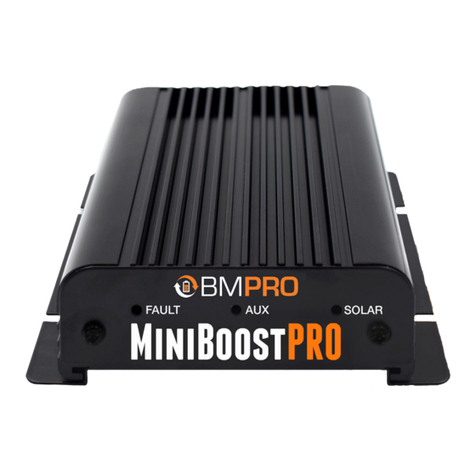
BM PRO
BM PRO MiniBoostPRO owner's manual
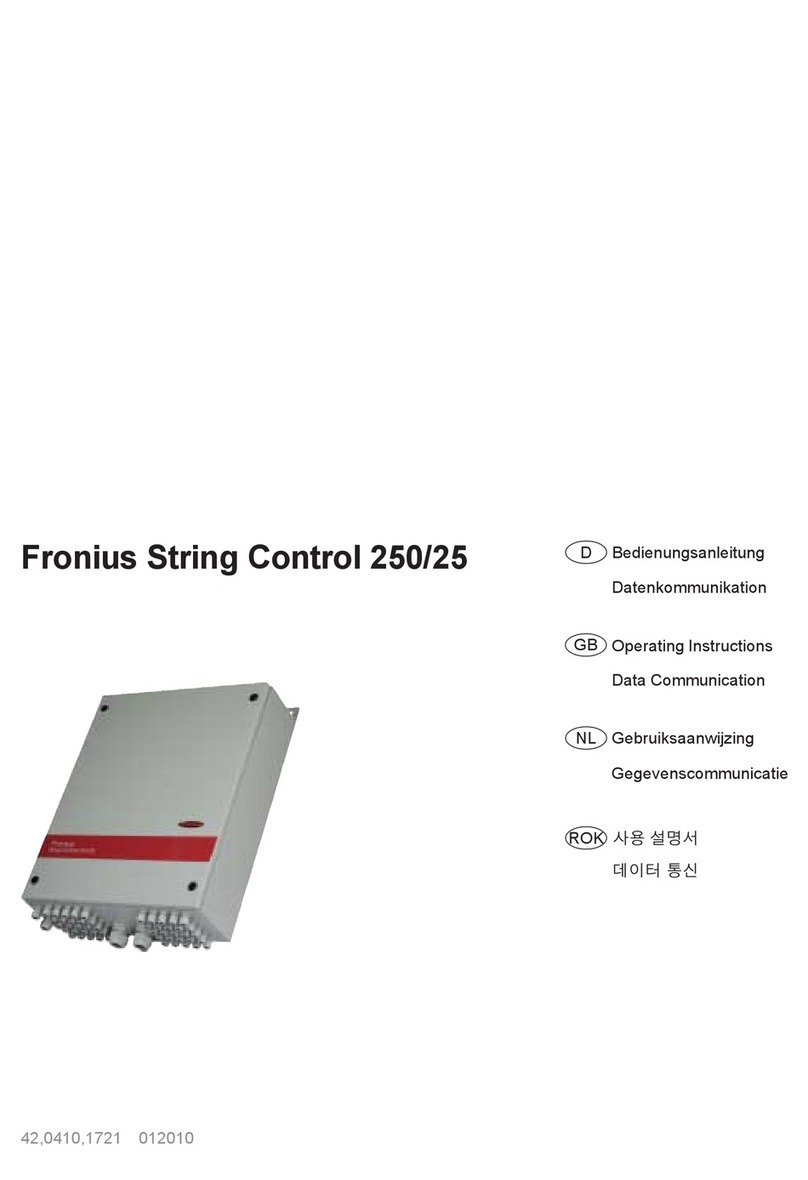
FRONIUS
FRONIUS String Control 250/25 operating instructions
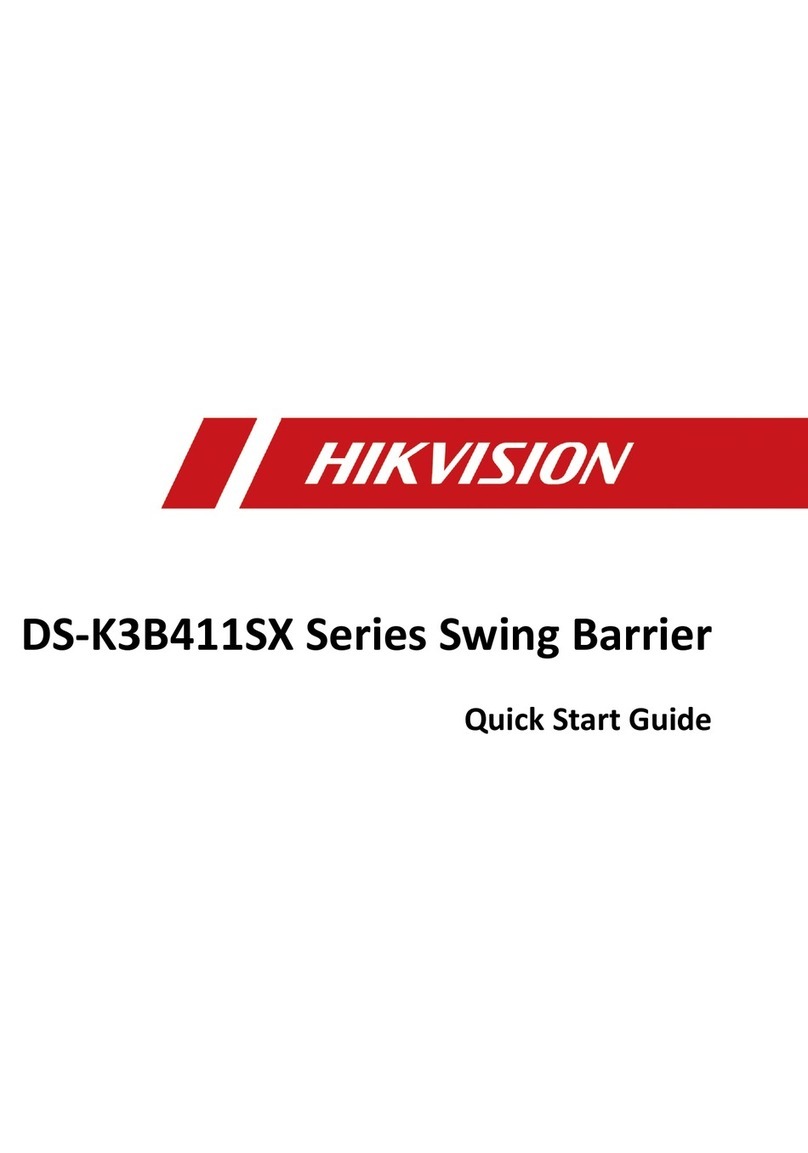
HIK VISION
HIK VISION DS-K3B411SX Series quick start guide
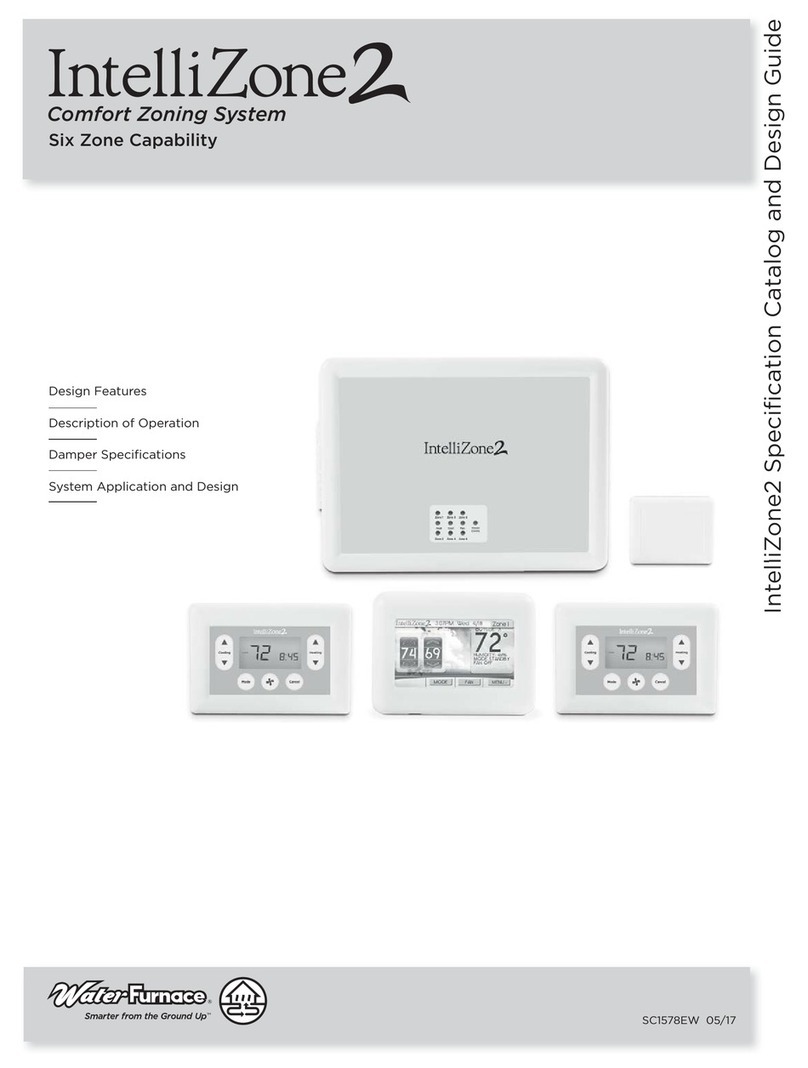
Water Furnace
Water Furnace IntelliZone2 MasterStat Specification Catalog and Design Guide
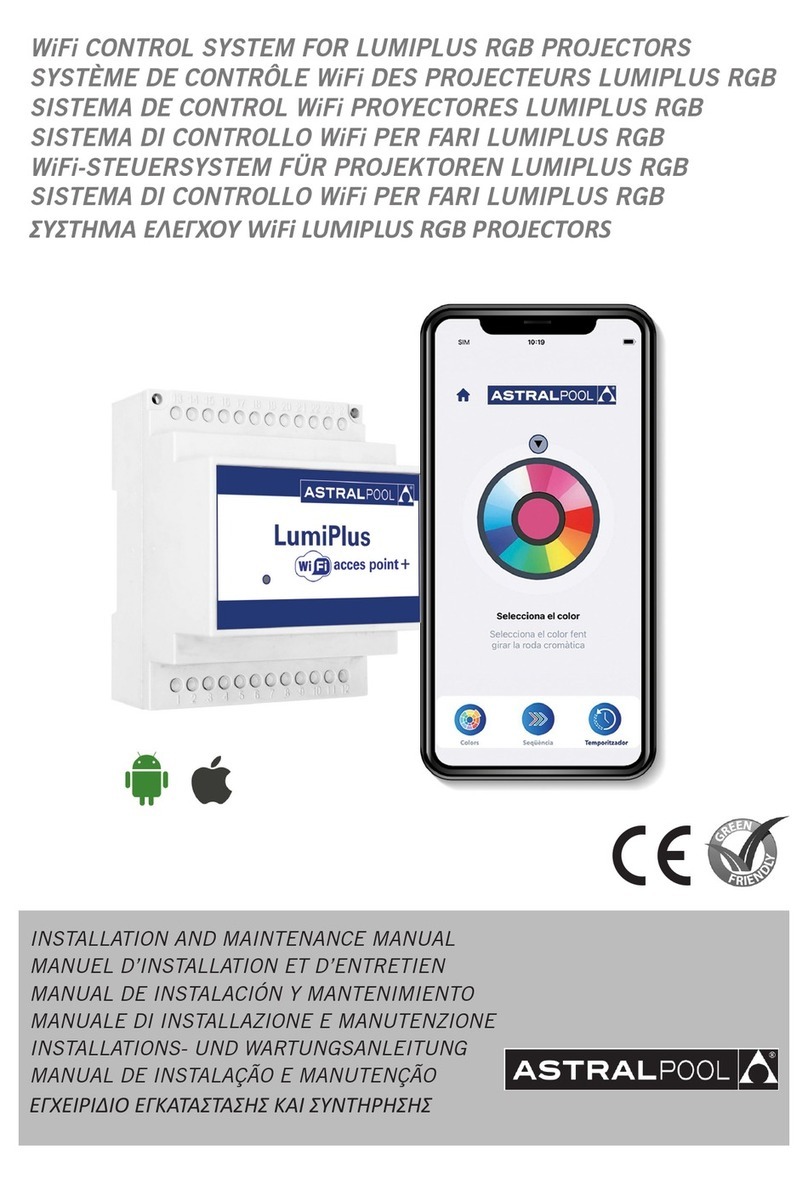
Astral Pool
Astral Pool LumiPlus 75813 Installation and maintenance manual
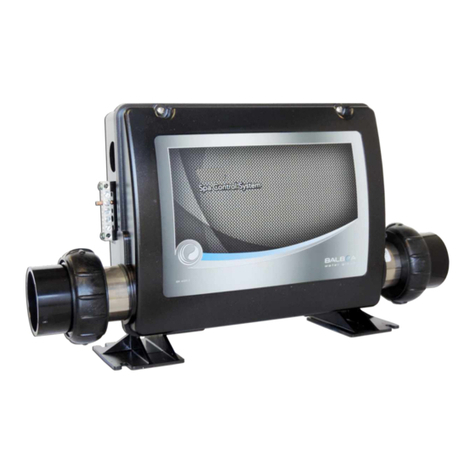
HydroQuip
HydroQuip BALBOA BP7 Series Installation & operation manual
